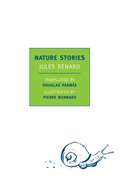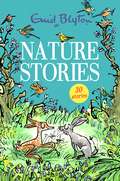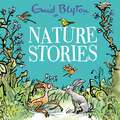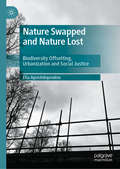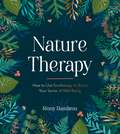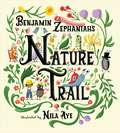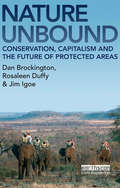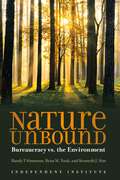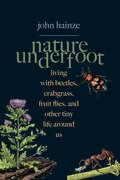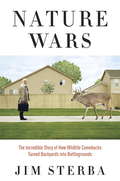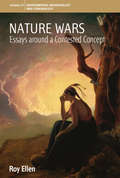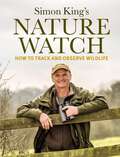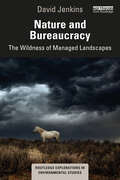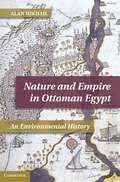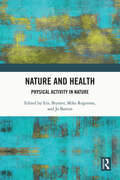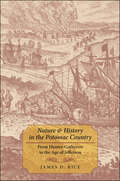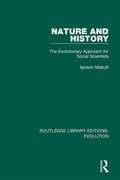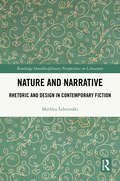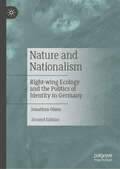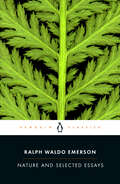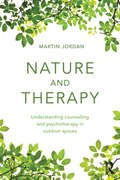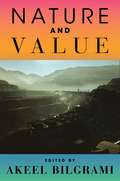- Table View
- List View
Nature Stories
by Jules RenardThe natural world in all its richness, glimpsed variously in the house, the barnyard, and the garden, in ponds and streams, and at large in the woods and the fields, including old friends like the dog, the cat, the cow, and the pig, along with more unusual and sometimes alarming characters such as the weasel, the dragonfly, snakes of several sorts, and even a whale, not to mention ants in their seeming infinitude and a single humble potato-all these and more are the subjects of what may well be the most deft and delightful book of literary miniatures ever written. In Jules Renard’s world, plants and animals not only feel but speak (one species, the swallow, appears to write Hebrew), and yet, for all the anthropomorphic wit and whimsy the author indulges in, they guard their mystery too. Sly, funny, and touching,Nature Stories, here beautifully rendered into English by Douglas Parmée and accompanied by the wonderful ink-brush images of Pierre Bonnard with which the book was originally published, is a literary classic of inexhaustible freshness.
Nature Stories: Contains 30 classic tales
by Enid BlytonA collection of thirty wonderful stories about the nature and the countryside from one of the world's best-loved children's authors; perfect to enjoy all year round.Enjoy the freedom of the outdoors, the beauty of the countryside and the charm of all creatures great and small in this bumper short-story collection. Enid Blyton loved the countryside, animals and birds and she wrote many wonderful stories to teach children all about the natural world. Each story is perfect for reading aloud to young children and is the ideal length for bedtime or classroom story time.***Enid Blyton ® and Enid Blyton's signature are Registered Trademarks of Hodder & Stoughton Limited. No trademark or copyrighted material may be reproduced without the express written permission of the trademark and copyright owner.
Nature Stories: Contains 30 classic tales (Bumper Short Story Collections #63)
by Enid BlytonA collection of thirty wonderful stories about the nature and the countryside from one of the world's best-loved children's authors; perfect to enjoy all year round.Enjoy the freedom of the outdoors, the beauty of the countryside and the charm of all creatures great and small in this bumper short-story collection. Enid Blyton loved the countryside, animals and birds and she wrote many wonderful stories to teach children all about the natural world. Each story is perfect for reading aloud to young children and is the ideal length for bedtime or classroom story time.***Enid Blyton ® and Enid Blyton's signature are Registered Trademarks of Hodder & Stoughton Limited. No trademark or copyrighted material may be reproduced without the express written permission of the trademark and copyright owner.
Nature Stories: Contains 30 classic tales (Bumper Short Story Collections #63)
by Enid BlytonA collection of thirty wonderful stories about the nature and the countryside from one of the world's best-loved children's authors.Enjoy the freedom of the outdoors, the beauty of the countryside and the charm of all creatures great and small in this bumper short-story collection. Enid Blyton loved the countryside, animals and birds and she wrote many wonderful stories to teach children all about the natural world. Each story is perfect for reading aloud to young children and is the ideal length for bedtime or classroom story time.***Enid Blyton ® and Enid Blyton's signature are Registered Trademarks of Hodder & Stoughton Limited. No trademark or copyrighted material may be reproduced without the express written permission of the trademark and copyright owner.(P)2020 Hodder & Stoughton Limited
Nature Swapped and Nature Lost: Biodiversity Offsetting, Urbanization and Social Justice
by Elia ApostolopoulouThis book unravels the profound implications of biodiversity offsetting for nature-society relationships and its links to environmental and social inequality. Drawing on people’s resistance against its implementation in several urban and rural places across England, it explores how the production of equivalent natures, the core promise of offsetting, reframes socionatures both discursively and materially transforming places and livelihoods.The book draws on theories and concepts from human geography, political ecology, and Marxist political economy, and aims to shift the trajectory of the current literature on the interplay between offsetting, urbanization and the neoliberal reconstruction of conservation and planning policies in the era following the 2008 financial crash. By shedding light on offsetting’s contested geographies, it offers a fundamental retheorization of offsetting capable of demonstrating how offsetting, and more broadly revanchist neoliberal policies, are increasingly used to support capitalist urban growth producing socially, environmentally and geographically uneven outcomes. Nature Swapped and Nature Lost brings forward an understanding of environmental politics as class politics and sees environmental justice as inextricably linked to social justice. It effectively challenges the dystopia of offsetting’s ahistorical and asocial non-places and proposes a radically different pathway for gaining social control over the production of nature by linking struggles for the right to the city with struggles for the right to nature for all.
Nature Therapy: How to Use Ecotherapy to Boost Your Sense of Well-Being
by Rémy DambronNature therapy is the practice of reconnecting with the natural world to refresh your physical and mental well-being. Including tips to help you discover your connection with the outdoors, activity inspiration and a holistic approach to wellness, this book is the ultimate guide to unlocking the transformative power of nature.
Nature Therapy: How to Use Ecotherapy to Boost Your Sense of Well-Being
by Rémy DambronNature therapy is the practice of reconnecting with the natural world to refresh your physical and mental well-being. Including tips to help you discover your connection with the outdoors, activity inspiration and a holistic approach to wellness, this book is the ultimate guide to unlocking the transformative power of nature.
Nature Trail: A joyful rhyming celebration of the natural wonders on our doorstep
by Benjamin ZephaniahA joyful celebration of nature and the wonder of the world around us by legendary poet and performer Benjamin Zephaniah, one of The Times' top 50 British post-war writers.At the bottom of my garden, there's a hedgehog and a frog,And a lot of creepy-crawlies living underneath a log . . .All around us, from parks to gardens and flowerpots to pavements, there's a world of wonder just waiting to be discovered. Why not look a little closer and see what you find?This joyful celebration of nature reminds us all to take a closer look at the world around us, and enjoy the wonder of nature wherever we find it. Packed with animals and minibeasts galore, this imaginative rhyming text is perfect for reading aloud.
Nature Unbound: "Conservation, Capitalism and the Future of Protected Areas"
by Rosaleen Duffy Dan Brockington Jim IgoeThis groundbreaking volume is the first comprehensive, critical examination of the rise of protected areas and their current social and economic position in our world. It examines the social impacts of protected areas, the conflicts that surround them, the alternatives to them and the conceptual categories they impose. The book explores key debates on devolution, participation and democracy; the role and uniqueness of indigenous peoples and other local communities; institutions and resource management; hegemony, myth and symbolic power in conservation success stories; tourism, poverty and conservation; and the transformation of social and material relations which community conservation entails. For conservation practitioners and protected area professionals not accustomed to criticisms of their work, or students new to this complex field, the book will provide an understanding of the history and current state of affairs in the rise of protected areas. It introduces the concepts, theories and writers on which critiques of conservation have been built, and provides the means by which practitioners can understand problems with which they are wrestling. For advanced researchers the book will present a critique of the current debates on protected areas and provide a host of jumping off points for an array of research avenues
Nature Unbound: Bureaucracy vs. the Environment
by Ryan M. Yonk Randy T Simmons Kenneth J. SimWhat if what we think we know about ecology and environmental policy is just wrong? What if environmental laws often make things worse? What if the very idea of nature has been hijacked by politics? What if wilderness is something we create in our minds, as opposed to being an actual description of nature?In 1934, former U.S. Forest Service offcial Aldo Leopold, a godfather to the modern environmental movement, wrote that &“restrictive laws&” had &“largely failed&” in their mission to conserve America&’s forests, rivers, and other natural resources. Less than forty years later, however, as various events pushed environmental concerns into the public spotlight, lawmakers from both parties championed legislation far more sweeping and restrictive than any Leopold had witnessed. How well did these &“restrictive laws&” work to right environmental wrongs? Why did so many miss the mark? And how should we go about improving our policies? In Nature Unbound, authors Randy Simmons, Ryan M. Yonk, and Kenneth J. Sim offer a devastating critique of federal environmental policy by scrutinizing it through the lenses of biological ecology and political ecology. This powerful framework, they show, reveals that environmental policy has been guided since the late 1960s by demonstrably false assumptions responsible for a host of ineffective or wasteful, command-and-control policies—on air pollution, water pollution, endangered species, wilderness, renewable energy, and more. The mistakes have also empowered political entrepreneurship in ways that have encroached on property rights, burdened the general public, and degraded the civic landscape. More than a critique of false assumptions and flawed policies, Nature Unbound offers bold principles to help us rethink environmental objectives, align incentives with goals, and af?rm the notion that human beings are an integral part of the natural order and merit no less consideration than Earth&’s other treasures. Ultimately, nothing less can succeed in our efforts to restore natural resources and revitalize our social and political ecosystem.
Nature Underfoot: Living with Beetles, Crabgrass, Fruit Flies, and Other Tiny Life Around Us
by John HainzeAn informed and heartfelt tribute to commonly unappreciated plants, insects, and other tiny creatures that reconsiders humanity&’s relationship to nature Fruit flies, silverfish, dandelions, and crabgrass are the bane of many people and the target of numerous chemical and physical eradication efforts. In this compelling reassessment of the relationship between humans and the natural world, John Hainze—an entomologist and former pesticide developer—considers the fascinating and bizarre history of how these so-called invasive or unwanted pests and weeds have coevolved with humanity and highlights the benefits of a greater respect and moral consideration toward these organisms. With deep insight into the lives of the underappreciated and often reviled creatures that surround us, Hainze&’s accessible and engaging natural history draws on ethics, religion, and philosophy as he passionately argues that creepy crawlies and unwanted plants deserve both empathy and accommodation as partners dwelling with us on earth.
Nature Wars
by Jim SterbaThis may be hard to believe but it is very likely that more people live in closer proximity to more wild animals, birds and trees in the eastern United States today than anywhere on the planet at any time in history. For nature lovers, this should be wonderful news -- unless, perhaps, you are one of more than 4,000 drivers who will hit a deer today, your child's soccer field is carpeted with goose droppings, coyotes are killing your pets, the neighbor's cat has turned your bird feeder into a fast-food outlet, wild turkeys have eaten your newly-planted seed corn, beavers have flooded your driveway, or bears are looting your garbage cans. For 400 years, explorers, traders, and settlers plundered North American wildlife and forests in an escalating rampage that culminated in the late 19th century's "era of extermination." By 1900, populations of many wild animals and birds had been reduced to isolated remnants or threatened with extinction, and worry mounted that we were running out of trees. Then, in the 20th century, an incredible turnaround took place. Conservationists outlawed commercial hunting, created wildlife sanctuaries, transplanted isolated species to restored habitats and imposed regulations on hunters and trappers. Over decades, they slowly nursed many wild populations back to health. But after the Second World War something happened that conservationists hadn't foreseen: sprawl. People moved first into suburbs on urban edges, and then kept moving out across a landscape once occupied by family farms. By 2000, a majority of Americans lived in neither cities nor country but in that vast in-between. Much of sprawl has plenty of trees and its human residents offer up more and better amenities than many wild creatures can find in the wild: plenty of food, water, hiding places, and protection from predators with guns. The result is a mix of people and wildlife that should be an animal-lover's dream-come-true but often turns into a sprawl-dweller's nightmare.Nature Wars offers an eye-opening look at how Americans lost touch with the natural landscape, spending 90 percent of their time indoors where nature arrives via television, films and digital screens in which wild creatures often behave like people or cuddly pets. All the while our well-meaning efforts to protect animals allowed wild populations to burgeon out of control, causing damage costing billions, degrading ecosystems, and touching off disputes that polarized communities, setting neighbor against neighbor. Deeply researched, eloquently written, counterintuitive and often humorous Nature Wars will be the definitive book on how we created this unintended mess. From the Hardcover edition.
Nature Wars: Essays Around a Contested Concept (Environmental Anthropology and Ethnobiology #27)
by Roy EllenOrganized around issues, debates and discussions concerning the various ways in which the concept of nature has been used, this book looks at how the term has been endlessly deconstructed and reclaimed, as reflected in anthropological, scientific, and similar writing over the last several decades. Made up of ten of Roy Ellen’s finest articles, this book looks back at his ideas about nature and includes a new introduction that contextualizes the arguments and takes them forward. Many of the chapters focus on research the author has conducted amongst the Nuaulu people of eastern Indonesia.
Nature Watch: How To Track and Observe Wildlife
by Simon KingNature Watch is the ultimate guide to watching British wildlife, from renowned naturalist and TV presenter Simon King.More and more people are discovering the joys of being out and about in the British countryside. Yet surprisingly few of us know where and what to look for when spotting wild animals in their natural habitats.In Nature Watch Simon King teaches you how to use your eyes and ears to find and follow creatures, how to identify tracks and signs that will lead you closer to them, and how to move without disturbing animals.Much more than just a nature handbook, Simon offers insider knowledge to help you get closer to the wild: Nature Watch also includes a chapter on the essential kit you will need to get started and offers photography tips, along with Simon’s amazing images, to help you get the best possible view of the nation’s favourite mammals, birds, mini-beasts, amphibians and more.
Nature and Bureaucracy: The Wildness of Managed Landscapes (Routledge Explorations in Environmental Studies)
by David JenkinsThis book questions how bureaucracies conceive of, and consequently interact with, nature, and suggests that our managed public landscapes are neither entirely managed nor entirely wild, and offers several warnings about bureaucracies and bureaucratic mentality. One prominent challenge facing scientists, policymakers, environmental activists, and environmentally concerned citizens, is to recognize that human influence in the natural world is pervasive and has a long history. How we act, or choose not to act, today will continue to determine the future of the natural world. Western-style management of nature, mediated by economic rationality and state bureaucracies, may not be the best strategy to maintain environmental integrity. The question is, what kinds of human influence, conceived of in the widest possible sense, will produce ideal environments for future generations? The related question is, who gets to choose? The author approaches the problem of analyzing the mutual influence of human and natural systems from two perspectives: as an objective scholar investigating bureaucracies and natural systems from the outside, and over the last decade as an inside practitioner working in various roles in federal land management agencies developing policies and regulations involved in the control of natural systems. This book will be of great interest to students and scholars of natural resource management, policy and politics, and professionals working in environmental management roles as well as policymakers involved in public policy and administration.
Nature and Empire in Ottoman Egypt
by Alan MikhailIn one of the first environmental histories of the Ottoman Empire, Alan Mikhail examines relations between the empire and its most lucrative province of Egypt. Based on both the local records of various towns and villages in rural Egypt and the imperial orders of the Ottoman state, this book charts how changes in the control of natural resources fundamentally altered the nature of Ottoman imperial sovereignty in Egypt and throughout the empire. In revealing how Egyptian peasants were able to use their knowledge and experience of local environments to force the hand of the imperial state, Nature and Empire in Ottoman Egypt tells a story of the connections of empire stretching from canals in the Egyptian countryside to the palace in Istanbul, from Anatolian forests to the shores of the Red Sea, and from a plague flea's bite to the fortunes of one of the most powerful states of the early modern world.
Nature and Empire in Ottoman Egypt: An Environmental History
by Alan MikhailIn one of the first environmental histories of the Ottoman Empire, Alan Mikhail examines relations between the empire and its most lucrative province of Egypt. Based on both the local records of various towns and villages in rural Egypt and the imperial orders of the Ottoman state, this book charts how changes in the control of natural resources fundamentally altered the nature of Ottoman imperial sovereignty in Egypt and throughout the empire. In revealing how Egyptian peasants were able to use their knowledge and experience of local environments to force the hand of the imperial state, Nature and Empire in Ottoman Egypt tells a story of the connections of empire stretching from canals in the Egyptian countryside to the palace in Istanbul, from Anatolian forests to the shores of the Red Sea, and from a plague flea's bite to the fortunes of one of the most powerful states of the early modern world.
Nature and Health: Physical Activity in Nature (Routledge Research in Health, Nature and the Environment)
by Eric Brymer Jo Barton Mike RogersonExperiences in nature are now recognised as being fundamental to human health and well-being. Physical activity in nature has been posited as an important well-being facilitator because the presence of nature augments the benefits of physical activity while also enhancing motivation and adherence. This volume brings together a mix of cutting edge ideas in research, theory and practice from a wide set of disciplines with the purpose of exploring interdisciplinary or trans-disciplinary approaches to understanding the relationship between physical activity in nature and health and well-being. Nature and Health: Physical Activity in Nature is structured to facilitate ease of use for the researcher, policy maker, practitioner or theorist. Section 1 covers research on physical activity in nature for a number of important health and well-being issues. Each chapter in this section considers how policy and practice might be shaped by current research findings and knowledge. Section 2 considers contemporary theoretical and conceptual understandings that help explain how physical activity in nature enhances health and well-being and also how best to design interventions and research. Section 3 provides examples of current approaches. This book is an ideal resource for both researchers and advanced students interested in designing future-proofed research, for policy makers interested in improving community well-being and for practitioners interested in best practice applications.
Nature and History in the Potomac Country: From Hunter-Gatherers to the Age of Jefferson
by James D. RiceHow environmental forces, and human responses to them, profoundly shaped both Native American and colonial life along the Potomac River.James D. Rice’s fresh study of the Potomac River basin begins with a mystery. Why, when the whole of the region offered fertile soil and excellent fishing and hunting, was nearly three-quarters of the land uninhabited on the eve of colonization? Rice wonders how the existence of this no man’s land influenced nearby Native American and, later, colonial settlements. Did it function as a commons, as a place where all were free to hunt and fish? Or was it perceived as a strange and hostile wilderness? Rice discovers environmental factors at the center of the story. Making use of extensive archaeological and anthropological research, as well as the vast scholarship on farming practices in the colonial period, he traces the region’s history from its earliest known habitation. With exceptionally vivid prose, Rice makes clear the implications of unbridled economic development for the forests, streams, and wetlands of the Potomac River basin. With what effects, Rice asks, did humankind exploit and then alter the landscape and the quality of the river’s waters? Equal parts environmental, Native American, and colonial history, Nature and History in the Potomac Country is a useful and innovative study of the Potomac River, its valley, and its people.
Nature and History: The Evolutionary Approach for Social Scientists (Routledge Library Editions: Evolution #6)
by Ignazio MasulliOriginally published in 1990, Nature and History examines how Darwin’s theory of evolution has been expanded by scholars and researchers to include virtually every scientific discipline. The book presents a morphological analysis of historical and social sciences – sciences which have traditionally have been viewed as too random in their progressions to conform to a model. Through the evaluation of empirical and factual evidence, the book builds a case for an evolutionary paradigm which encompasses both natural and social sciences, and presents the form’s adaptiveness in working historical models.
Nature and Narrative: Rhetoric and Design in Contemporary Fiction (Routledge Interdisciplinary Perspectives on Literature)
by Markku LehtimäkiThe book explores environmental issues in twenty-first-century Anglophone fiction and how those issues are dealt with by specific literary means. It proposes a reciprocal relationship between nature and narrative—the idea according to which nature both informs and inspires artistic creations, while literary designs and rhetoric also shape our ideas and perceptions of the natural environment. It is argued that in order to address design and rhetoric in environmental texts, we need a close analysis of those world-shaping functions of literary narratives that unite ecocritical and narratological interests. The author presents readings of contemporary novels and their varying ways of seeing nature through narrative devices and fictional minds. The novels discussed in the book are Hilary Mantel’s Wolf Hall, Toni Morrison’s A Mercy, Ian McGuire’s The North Water, Barbara Kingsolver’s The Lacuna, Paul Harding’s Tinkers and Enon, J. M. Coetzee’s Elizabeth Costello, Ian McEwan’s Solar, and Jenny Offill’s Weather.
Nature and Nationalism: Right-wing Ecology and the Politics of Identity in Germany
by Jonathan OlsenIn this new edition of his now classic 1999 book, Jonathan Olsen explores the relationship between the far right and the environment, or what he terms “right-wing ecology.” Arguing that radical environmentalism is not exclusively a domain of the left, Olsen shows how many of Germany's far right parties and groups ground their ecological ideology in an anti-universalist anthropology which sees human beings as naturally 'rooted' in specific nations and cultural traditions. Pollution in this discourse signifies not only the disruption of the natural world, but the social world as well, thus providing an environmental justification for an anti-immigrant politics which finds resonance outside the specific milieu of the far right. A rigorously theoretical book, Nature and Nationalism challenges our understanding of the deeply ambiguous ways in which 'nature' functions to legitimate a wide variety of political ideas.
Nature and Selected Essays
by Ralph Waldo EmersonAn indispensible look at Emerson's influential life philosophyThrough his writing and his own personal philosophy, Ralph Waldo Emerson unburdened his young country of Europe's traditional sense of history and showed Americans how to be creators of their own circumstances. His mandate, which called for harmony with, rather than domestication of, nature, and for a reliance on individual integrity, rather than on materialistic institutions, is echoed in many of the great American philosophical and literary works of his time and ours, and has given an impetus to modern political and social activism.Larzer Ziff's introduction to this collection of fifteen of Emerson's most significant writings provides the important backdrop to the society in which Emerson lived during his formative years.For more than seventy years, Penguin has been the leading publisher of classic literature in the English-speaking world. With more than 1,700 titles, Penguin Classics represents a global bookshelf of the best works throughout history and across genres and disciplines. Readers trust the series to provide authoritative texts enhanced by introductions and notes by distinguished scholars and contemporary authors, as well as up-to-date translations by award-winning translators.
Nature and Therapy: Understanding Counselling and Psychotherapy in Outdoor Spaces
by Martin JordanRecent decades have seen an increasing interest in the healing and therapeutic potential of nature and interest in the potential of greencare interventions for the benefit of mental health. The field of nature based therapies is expanding in line with this interest. Nature and Therapy offers a unique contribution by outlining the specific processes involved in conducting counselling and psychotherapy sessions in outdoor natural environments. Central areas covered in the book include: A thorough exploration of the evidence for the psychological and healing potential of natural spaces; Developing a therapeutic rationale for nature based therapeutic work; Understanding the therapeutic relationship and the unique therapeutic processes that come into play in outdoor natural spaces; Translating indoor therapeutic work to outdoor contexts; The practicalities of setting up and running a therapy session outside of a room environment; and experiential exercises to explore the therapeutic potential of nature.
Nature and Value
by Jonathan Schell Jedediah Purdy Nikolas Kompridis David Bromwich Carol Rovane Joanna Picciotto Robert Pollin Sanjay Reddy Jan Zalasiewicz Bina Gogineni Anthony Laden Kyle Nichols James Hamilton TullyToday, as we confront an unprecedented environmental crisis of our own making, it is more urgent than ever to consider the notion of nature and our place within it. This book brings together essays that individually and as a whole present a detailed and rigorous multidisciplinary exploration of the concept of nature and its wider ethical and political implications.A distinguished list of scholars take up a broad range of questions regarding the relations between the human subject and its natural environment: when and how the concept of nature gave way to the concept of natural resources; the genealogy of the concept of nature through political economy, theology, and modern science; the idea of the Anthropocene; the prospects for green growth; and the deep alienation of human beings in the modern period from both nature and each other. By engaging with a wide range of scholarship, they ultimately converge on a common outlook that is both capacious and original. The essays together present a revaluation of the natural world that seeks to reshape political and ethical ideals and practice with a view to addressing some of the fundamental concerns of our time.Nature and Value features widely known scholars in a broad swath of disciplines, ranging from philosophy, politics, and political economy to geology, law, literature, and psychology. They include Jonathan Schell, David Bromwich, James Tully, Jedediah Purdy, Robert Pollin, Jan Zalasiewicz, Carol Rovane, Sanjay Reddy, Joanna Picciotto, Anthony Laden, Nikolas Kompridis, Bina Gogineni, Kyle Nichols, and the editor, Akeel Bilgrami.
